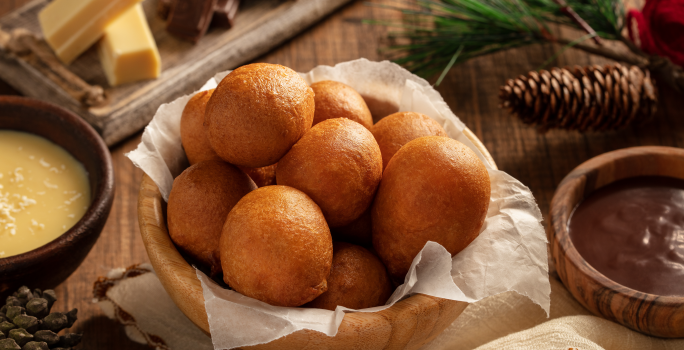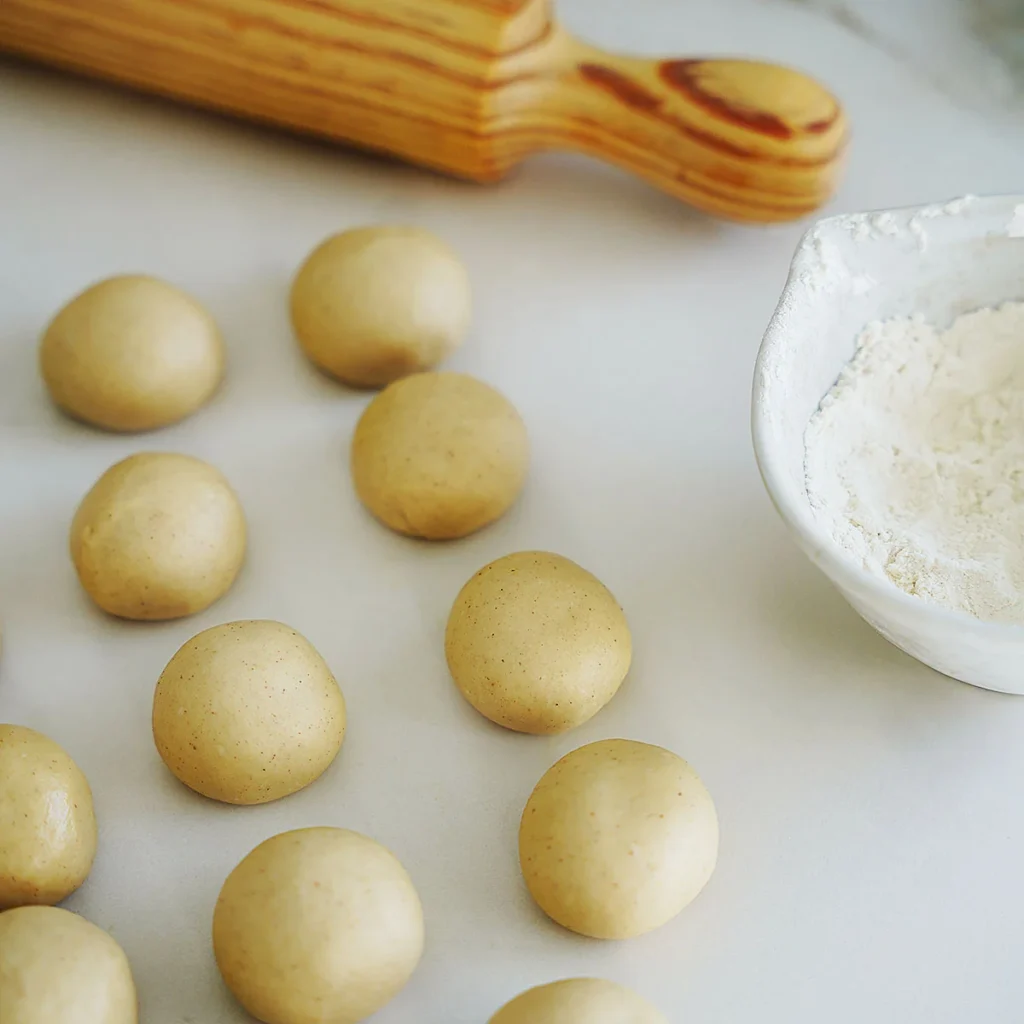Colombian buñuelos are not just a food item; they are a festive symbol, deeply rooted in the culture and traditions of Colombia. These delectable fried dough balls offer a unique taste experience, combining sweet and savory flavors that have made them a favorite not only in Colombia but around the world.
In this comprehensive guide, we dive into the heart of buñuelos Colombian food, exploring their ingredients, preparation methods, cultural significance, and nutritional information.

What are Colombian Buñuelos Made Of?
The primary ingredients of Colombian buñuelos are a testament to the simplicity and richness of Colombian cuisine. At their core, these mouthwatering treats are made from a dough comprising cassava flour (also known as yuca flour) and cornstarch, which gives them their distinctive light and airy texture.
The dough is enriched with queso fresco (fresh cheese), adding a subtle yet irresistible cheesy flavor. A touch of sugar balances the savory with a mild sweetness, while milk and eggs bind the mixture together, creating a smooth and pliable dough ready for frying.
The Global Appeal of Buñuelos
While buñuelos are a staple in Colombian festivities, particularly during Christmas and New Year’s celebrations, their popularity crosses borders. Variants of buñuelos can be found in many countries, each adding a local twist to the recipe.
From the cheese-filled versions in Mexico to the sweet, syrupy buñuelos in Spain, this versatile snack has made its mark worldwide. In Venezuela and Cuba, buñuelos are shaped into intricate figures and soaked in syrup, showcasing the diverse culinary interpretations of this beloved treat.

Nutritional Insights: How Many Calories in a Colombian Buñuelo?
Understanding the nutritional content of Colombian buñuelos is crucial for those who enjoy indulging in these treats mindfully. A single Colombian buñuelo typically contains about 200 to 250 calories. Given their fried nature, buñuelos are rich in fats, but they also offer a good amount of protein thanks to the cheese content. While buñuelos are undoubtedly a delicious treat, enjoying them in moderation is key to maintaining a balanced diet.
The Art of Making Buñuelos

Making Colombian buñuelos at home is an enjoyable process that allows you to connect with Colombian culinary traditions. The dough should be mixed thoroughly until smooth and homogenous. Small portions are then rolled into balls and deep-fried in vegetable oil at a medium temperature. The magic happens when the buñuelos float to the surface, turning golden and crispy on the outside while remaining soft and cheesy on the inside. Achieving the perfect buñuelo requires patience and practice, but the result is incredibly rewarding.
Celebrating with Buñuelos: A Cultural Tradition
In Colombia, buñuelos are more than just a snack; they are a vital part of holiday celebrations, particularly during Christmas. Families gather to prepare and enjoy buñuelos together, accompanied by other traditional dishes and drinks such as natilla and aguardiente. This communal cooking and eating experience strengthens bonds and celebrates the nation’s rich cultural heritage.

How To Make Colombian Bunuelos
Making Colombian buñuelos is a delightful journey into the heart of Colombian cuisine, offering a taste of its rich traditions and festive spirit. These cheese-flavored, fried dough balls are a staple during Colombian holidays, especially Christmas and New Year, but their irresistible taste makes them a beloved treat year-round. Follow this step-by-step guide to bring a piece of Colombia into your kitchen.
Ingredients:
- 1 cup cassava flour (yuca flour)
- 1 cup cornstarch
- 2 cups queso fresco (or any fresh cheese that crumbles easily, like feta as a substitute)
- 3 tablespoons sugar
- 1 teaspoon baking powder
- 2 eggs
- About ½ cup milk (adjust as needed to get the right dough consistency)
- Vegetable oil for frying

Instructions:
1. Prepare the Dough:
- In a large mixing bowl, combine the cassava flour, cornstarch, and baking powder. Mix these dry ingredients well to ensure even distribution.
- Add the crumbled queso fresco and sugar to the bowl, mixing thoroughly until the ingredients are well combined.
- Beat the eggs lightly and mix them into the dough, adding them gradually to the flour and cheese mixture.
- Gradually add milk to the mixture. Start with a small amount, adding more as needed, until the dough is smooth, pliable, and not too sticky. The goal is to have a dough that can be easily shaped into balls without falling apart.

2. Shape the Buñuelos:
Once your dough has reached the right consistency, take small portions and roll them into balls about the size of a golf ball. The smoothness of the balls will prevent cracks during frying, ensuring they puff up nicely.

3. Fry the Buñuelos:
- Heat a generous amount of vegetable oil in a deep frying pan over medium heat. You want enough oil so the buñuelos can float freely without touching the bottom of the pan.
- To test if the oil is hot enough, drop a small piece of dough into the oil. If it bubbles and rises to the surface, the oil is ready.
- Carefully place the dough balls into the hot oil. Don’t overcrowd the pan, as the buñuelos need space to expand and float.
- Fry the buñuelos until they are golden brown and have a crispy exterior, which usually takes about 5 to 7 minutes. They should turn themselves in the oil, but you may need to gently nudge them to ensure even browning.
- Once they’re golden and crispy, remove the buñuelos with a slotted spoon and place them on a paper towel-lined plate to drain any excess oil.

4. Serving:
Colombian buñuelos are best enjoyed warm, offering a crispy exterior with a soft, cheesy interior. Serve them as a snack, for breakfast, or as part of a festive meal.

Tips for Perfect Buñuelos:
- Cheese: The type of cheese used can greatly affect the flavor and texture of your buñuelos. Queso fresco is traditional, but feel free to experiment with different cheeses that crumble well.
- Oil Temperature: Maintaining the right oil temperature is crucial. If it’s too hot, the buñuelos will brown too quickly without cooking through. Too cool, and they’ll absorb too much oil, becoming greasy.
- Consistency: The dough should be firm enough to hold its shape but soft enough to be easily molded. If it’s too dry, add a bit more milk; if too sticky, a little more cassava flour or cornstarch.
Enjoy the process of making these traditional Colombian treats, and don’t forget to share them with family and friends. Buñuelos are not just a delicious snack; they’re a way to bring people together, celebrate Colombian culture, and enjoy the simple pleasures of homemade food.
Conclusion
Colombian buñuelos are a culinary treasure, embodying the warmth and richness of Colombian culture. Their simple yet delicious ingredients, combined with a deep-rooted tradition of communal cooking and celebration, make buñuelos a beloved treat enjoyed not only in Colombia but around the globe.
Whether you’re savoring them as part of a festive gathering or enjoying a quiet moment of indulgence, Colombian buñuelos offer a taste of Colombian hospitality and joy.
Disclosure: Our blog contains affiliate links to products. We may receive a commission for purchases made through these links. However, this does not impact our reviews and comparisons. We try our best to keep things fair and balanced, in order to help you make the best choice for you.






